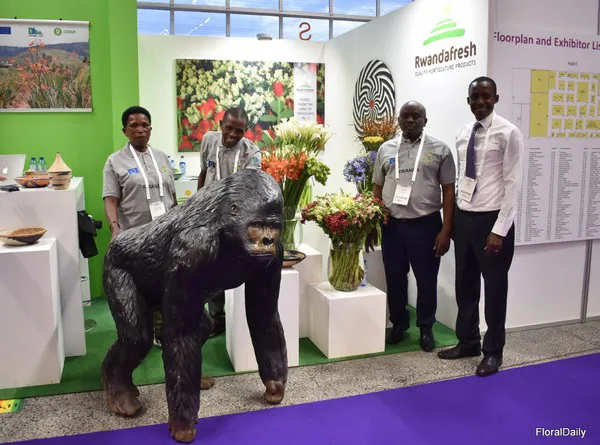Rwanda's floriculture industry and horticulture sub-sector have grown significantly over the last few years. Rwanda's horticulture sub-sector (mainly flowers, vegetables, and fruits) generated over $28.79 million, slightly higher than the $28.7 million in the previous fiscal year, according to data from NAEB.
According to NAEB agriculture Export Performance Report 2020/2021[i], traditional commodities, mainly coffee and tea, did not perform well as expected due to the effects of COVID-19, which led to the closing of coffee consumer companies and consequently reduced Rwanda's coffee exports by 14.41%.
Surprisingly, as coffee export volumes reduced, flower export volumes increased by 58.79% in the same period. Although the performance came as a surprise to many, it is part of Rwanda's larger strategic plan for agriculture transformation (2018-2024). The strategic plan sets out an ambitious target of exporting 34,104,000 stems of flowers in 2024 compared to 8,500,000 in 2018. The floriculture industry is increasingly becoming a more attractive industry to invest in.
Oxfam is one of the actors in the floriculture industry in Rwanda, supporting smallholder farmers and farmer cooperatives to increase production and flower exporters to the international markets. In this article, Godfrey Gakwandi, from Oxfam Rwanda, explains more about the floriculture industry in Rwanda, its growth, potential, future, and challenges.

Margueritte Mukamazimpaka, farmer Rulindo District Augustin Gasana, farmer Rulindo District Janvier Ugeziwe, Duhamic-ADRI Godfrey Gakwandi, Oxfam
Floriculture in Rwanda
Over the past decade, not much attention was given to horticulture in general, explains Gakwandi. "Farmers used to grow vegetables and flowers for home use, and they never knew it could be a potential source of income." But in 2014, the government started to look more into this sub-sector. Using the baseline figure of 8.500,000 stems of flowers harvested in 2018, which were mainly exported to the Netherlands, the government quickly discovered that flower cultivation has huge potential for Rwanda's exports. The flower exporters mainly dealt in rose varieties, as summer flowers were mostly sold on the local market, yet they are grown in the country.
Increase flower exports
In 2020, with funding from the European Union (EU), Oxfam received a grant entitled "Sustainable Livelihoods in Horticulture Value Chains (2020-2024)" that aimed to unlock the potential of Rwanda's horticultural value chains (HVC) to sustainably supply safe and high-quality products to the local, regional, and international markets. The funding is intended to support the horticulture sub-sector, including the production of flowers, especially summer flowers. "They were usually only used for local events and not for exports. However, summer flower exports have huge potential because the climatical conditions in Rwanda are very suitable for summer flower cultivation." So, Oxfam started supporting the flower industry across the value chain. "To enable farmers to increase production, they need the right seeds, fertilizers, and so on, but they also need training on modern farming technologies that will allow farmers to increase the yield on the same land size."
The project works with other actors in flower value chains, like aggregators and exporters, that helped access post-harvest facilities – cold chains to reduce post-harvest losses, support them to acquire packaging, and educate them on how to manage the cold room. "We offer exporters grants to allow them to increase their export volume. However, one of the grant conditions is that they buy from flower farmer cooperatives under the "Contract farming framework. So far, under this framework, TM Quality Production Ltd and Bright Harvest Limited – both summer flower exporters to Europe - have received financial grants from our organization to increase flower exports. This way, the entire chain will benefit."
Expectations exceeded – government invests in industry
"The results exceeded everyone's expectations," he continues. "During the pandemic, the flower sales skyrocketed, exceeding the cash crops that used to be of most value for the government." So, the government decided to make a large investment for this industry to grow even further. "In late 2022, the government bought a cargo airline to facilitate the export of flowers and other agricultural crops and commodities. Dubai is the first destination, and more are expected to be added soon." According to Gakwandi, this investment will create huge opportunities for the industry to grow even more in the future. "Currently, most of the flowers go to international destinations via the Netherlands. Other destinations may be added in 2023 and open up more market opportunities, making Rwandan flowers more competitive on the market."
Potential recognized
The potential for the horticulture industry in Rwanda is recognized by many. "Besides the investment in the airlines, the government is also allocating land so that this industry can grow. The EU, which is one of the biggest funders of the agricultural sector in Rwanda, committed to financing initiatives to boost the sub-sectors development. Such projects include the Kigali wholesale market on land for horticulture commodities and improved cleaning, grading, drying, and storage of horticultural products to reduce post-harvest losses and increase export earnings."
He explains how the government offers a financial start to ease agricultural financing in which specific loan products for smallholder farmers and other value chain actors are given to access and invest in the flower industry and agriculture sector. "Similarly, insurance companies are now providing insurance covering horticulture commodities, for instance, chili, tomatoes, and other food crops. Flowers may be added to the list soon, given the role they play in exports. These are all signs that the industry is considered reliable."
Bright future
The developments mentioned above are all indicators that the future of the flower industry is bright in Rwanda. "Besides the commitment from the side of the government, the farmers have a new mindset. Before, flowers, particularly summer flowers, were grown for local use, but now that they know that it is a valuable crop, farmers of other crops are even shifting to flowers and are expanding acreage. After all, after planting, one can harvest summer flowers every week, whereas corn, for example, has to be harvested all at once after three months of patiently waiting."
Challenges
However, there are some challenges concerning the logistics. "The cold chain can be improved. We need climate-controlled vehicles that ship the flowers from the cold rooms, but these are very expensive. Also, when looking at transportation costs to the end destination, as we are landlocked, most of our exports go by air whereas the trend is going toward transportation by sea, in order to reduce the carbon emission."
Packaging is another challenge. "At the moment, the majority is imported, and prices are therefore very high. We need more investors so that more can be produced locally."
“Though Rwanda's commodities are naturally organic, international markets have rules and regulations on certification that are often expensive to abide by,” he concludes.
For more information Godfrey Gakwandi
Godfrey Gakwandi
Oxfam
Email: GGakwandi@oxfam.org.uk
https://www.oxfam.org.uk/
[i] https://naeb.gov.rw/fileadmin/Reports-Annual/NARRATIVE_ANNUAL_REPORT_2020-2021.pdf
